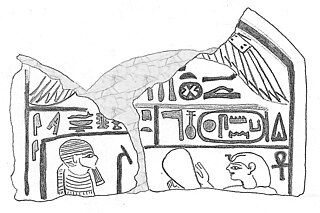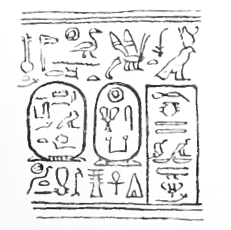
Hor Awibre was an Egyptian pharaoh of the early 13th Dynasty in the late Middle Kingdom.

Merhotepre Sobekhotep was an Egyptian king of the late 13th Dynasty during the Second Intermediate Period.

Sekhemkare Amenemhat V was an Egyptian pharaoh of the early 13th Dynasty during the Second Intermediate Period.
Renseneb Amenemhat was an Egyptian pharaoh of the 13th Dynasty during the Second Intermediate Period. According to egyptologist Kim Ryholt, Renseneb was the 14th king of the dynasty, while Detlef Franke sees him as the 13th ruler and Jürgen von Beckerath as the 16th. Renseneb is poorly attested and his throne name remains unknown.

Semenkare Nebnuni is a poorly attested pharaoh of the early 13th Dynasty during the Second Intermediate Period. He is mainly known for his position in the Turin King List.

Ameny Qemau was an Egyptian pharaoh of the early 13th Dynasty in the late Middle Kingdom.

Sehetepibre Sewesekhtawy was an Egyptian pharaoh of the 13th Dynasty during the early Second Intermediate Period, possibly the fifth or tenth king of the Dynasty.

Seankhibre Ameny Antef Amenemhat VI was an Egyptian pharaoh of the early Thirteenth Dynasty.
Sewadjkare was an Egyptian pharaoh of the 13th Dynasty during the early Second Intermediate Period.

Hotepibre Qemau Siharnedjheritef was an Egyptian pharaoh of the 13th Dynasty during the Second Intermediate Period.
Nedjemibre was an ephemeral Egyptian pharaoh of the 13th Dynasty of Egypt during the Second Intermediate Period reigning c. 1780 BC or 1736 BC.

Mersekhemre Ined was a pharaoh of the late 13th Dynasty, possibly the thirty-fifth king of this dynasty. As such he would have reigned from Memphis over Middle and Upper Egypt for a short time either during the early or mid-17th century, from 1672 until 1669 BC or from 1651 until 1648 BC. He may be the same king as Mersekhemre Neferhotep II.

Sekhemkare Amenemhat Senebef was an Egyptian pharaoh of the early 13th Dynasty, often considered as the final part of the late Middle Kingdom or early Second Intermediate Period.

Nerikare was an Egyptian pharaoh of the 13th Dynasty during the Second Intermediate Period.

Sekhemraneferkhau Wepwawetemsaf was an Egyptian pharaoh during the Second Intermediate Period.

Menkhaure Snaaib was an Egyptian pharaoh during the Second Intermediate Period between the Middle Kingdom and New Kingdom at the end of the Middle Bronze Age.

Sekhemrekhutawy Khabaw was an Egyptian pharaoh of the early 13th Dynasty during the Second Intermediate Period.

Sewahenre Senebmiu is a poorly attested Egyptian pharaoh during the Second Intermediate Period, thought to belong to the late 13th Dynasty.
Sewadjkare III was an Egyptian pharaoh of the Fourteenth Dynasty of Egypt during the Second Intermediate Period c. 1700 BC. As a king of the 14th Dynasty, Sewadjkare III would have reigned from Avaris over the eastern Nile Delta and possibly over the western Delta as well.

Sekheperenre was an Egyptian pharaoh of the 14th Dynasty of Egypt during the Second Intermediate Period. According to the Egyptologists Kim Ryholt and Darrell Baker, Sekheperenre was the twenty-second king of the dynasty; alternatively, Jürgen von Beckerath sees him as the seventeenth ruler. As a king of the 14th Dynasty, Sekheperenre would have reigned from Avaris over the eastern Nile Delta and possibly over the western Delta as well.















